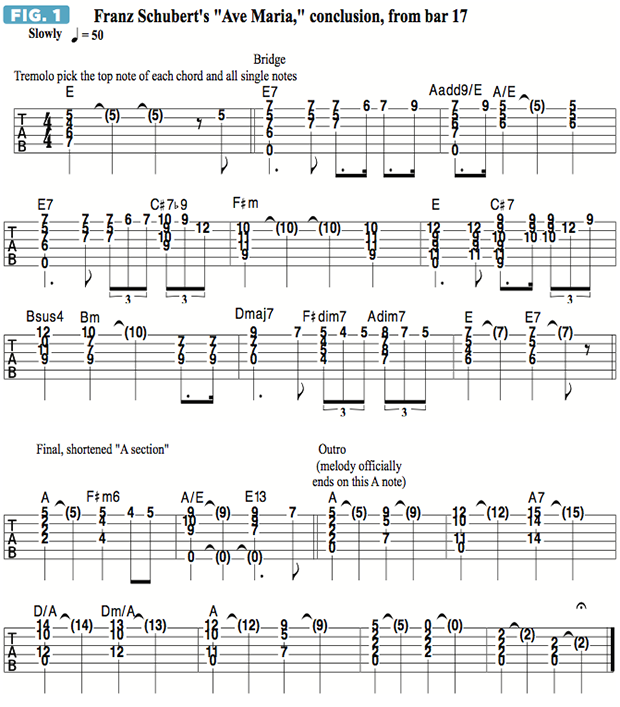String Theory with Jimmy Brown: The Conclusion of Franz Schubert’s “Ave Maria” for Guitar — Video

As promised last month, here is the rest of my solo instrumental guitar arrangement of that brilliant and ever-popular operatic song written in 1825 by classical-Romantic–era composer Franz Schubert and commonly referred to as “Ave Maria,” due to the religious lyrics that were later set to the tune (see FIGURE 1).
We pick up where we left off, at bar 17, which provides a slight pause on an E chord that ushers in the bridge section that follows and takes us to the end of the piece.
This final part of my arrangement continues the “minstrel”-style tremolo-picking-over-strummed-chords approach previously applied to the tune’s main theme after the five-bar intro (see bars 6–17 of FIGURE 1 from String Theory, November 2015) and ends with a shortened restatement of the main theme, which leads to a “soft-landing” outro that recalls the intro progression, only now played with tremolo picking and higher chord inversions.
Again, for those new to tremolo picking, it involves repeatedly picking the same note using fast alternate picking, in an effort to emulate the sustained notes of a human voice or instruments like the violin, trumpet or flute. What’s nice about the technique is that it enables you to be very expressive with volume contrasts and “swells,” by gradually varying the intensity of your pick strokes while maintaining an even stream of 16th notes, 16th-note triplets or 32nd notes. (The particular rhythm used depends on the tempo.)
Tremolo-pick the top note of each chord and all melody notes while trying to allow each chord to ring as long as possible. You’ll need to let go of them in a few spots, as your fret hand shifts to a different position while continuing the melody. There are a couple of chords, namely the E7 and Aadd9/E in bars 2, 3 and 4, for which you’ll need to strum all six strings while carefully making sure the unused open A string does not ring.
You can either avoid picking the A string by “jumping over” it as you strum, mute the A string with the tip of the finger that frets the D string, or both, which I recommend doing in order to achieve the cleanest articulation possible and ensure that the open A note does not sound, which would mar your performance. The same applies to the A/E chord in bar 11, only here you’ll need to carefully avoid sounding both the open A and D strings, which can only be done by first picking the open low E note and then quickly jumping over these two strings before strumming the A/E chord. You would then let the low E note ring into the E13 chord.
To optimally finger the sixth-fret melody notes on the high E string that follow the E7 chord in bars 2 and 4, “borrow” your middle finger from the chord shape, so that you don’t have to slide the pinkie down one fret and lose the two other ringing chord tones.

Get The Pick Newsletter
All the latest guitar news, interviews, lessons, reviews, deals and more, direct to your inbox!
Over the past 30 years, Jimmy Brown has built a reputation as one of the world's finest music educators, through his work as a transcriber and Senior Music Editor for Guitar World magazine and Lessons Editor for its sister publication, Guitar Player. In addition to these roles, Jimmy is also a busy working musician, performing regularly in the greater New York City area. Jimmy earned a Bachelor of Music degree in Jazz Studies and Performance and Music Management from William Paterson University in 1989. He is also an experienced private guitar teacher and an accomplished writer.

